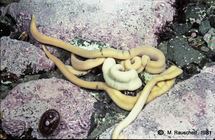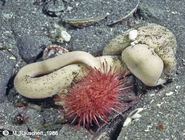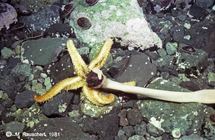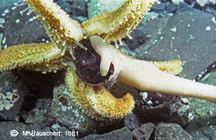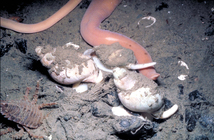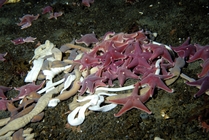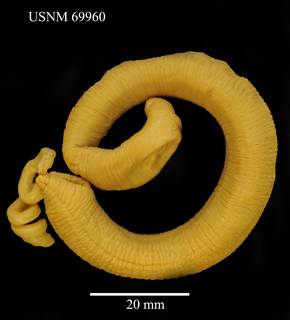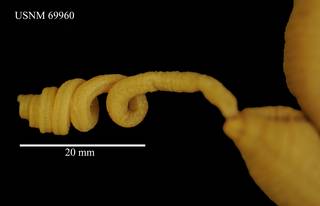WoRMS taxon details
Parborlasia corrugata (McIntosh, 1876)
155836 (urn:lsid:marinespecies.org:taxname:155836)
accepted
Species
Cerebratulus charcoti Joubin, 1905 · unaccepted
Cerebratulus corrugatus · unaccepted (synonym)
Cerebratulus hanseni · unaccepted (synonym)
Cerebratulus magelhaensicus Bürger, 1895 · unaccepted (synonym)
Cerebratulus steeneni Bürger, 1893 · unaccepted > misspelling - incorrect subsequent spelling (lapsus calami?)
Cerebratulus steineni Bürger, 1893 · unaccepted > junior subjective synonym
Cerebratulus steinini (Bürger, 1893) · unaccepted > misspelling - incorrect subsequent spelling (lapsus calami)
Cerebratulus subtilis Bürger, 1893 · unaccepted (synonym)
Lineus corrugatus McIntosh, 1876 · unaccepted (synonym)
Lineus hanseni Joubin, 1910 · unaccepted (Synonym)
Parborlasia corrugatus (McIntosh, 1876) · unaccepted > incorrect grammatical agreement of specific epithet
marine, fresh, terrestrial
(of Lineus corrugatus McIntosh, 1876) McIntosh, William Carmichael. (1876). Descriptions of some new species of Annelida from Kerguelen's Island. <em>Annals and Magazine of Natural History, Series 4.</em> 17(100): 318-323., available online at https://www.biodiversitylibrary.org/page/16011576 [details] 
Nomenclature The genus Parborlasia is grammatically feminine in gender, whereas the specific epithet undergoes the declension corrugatus...
Nomenclature The genus Parborlasia is grammatically feminine in gender, whereas the specific epithet undergoes the declension corrugatus (m.), corrugata (f.), and corrugatum (n.) for nominative singular. The specific name corrugatus McIntosh, 1876, in combination with Parborlasia, should thus be mandatorily changed to corrugata, under Articles 31.2 and 34.2 of the International Code of Zoological Nomenclature (4th ed.). [Note added by H. Kajihara, 2024] [details]
Norenburg, J.; Chernyshev, A.; Kajihara, H.; Maslakova, S. (2025). World Nemertea Database. Parborlasia corrugata (McIntosh, 1876). Accessed through: World Register of Marine Species at: https://www.marinespecies.org/aphia.php?p=taxdetails&id=155836 on 2025-07-18
Date
action
by
![]() The webpage text is licensed under a Creative Commons
Attribution 4.0 License
The webpage text is licensed under a Creative Commons
Attribution 4.0 License
Nomenclature
original description
(of Lineus corrugatus McIntosh, 1876) McIntosh, William Carmichael. (1876). Descriptions of some new species of Annelida from Kerguelen's Island. <em>Annals and Magazine of Natural History, Series 4.</em> 17(100): 318-323., available online at https://www.biodiversitylibrary.org/page/16011576 [details] 
original description (of Cerebratulus magelhaensicus Bürger, 1895) Bürger, O. (1895). Beitrage zur Anatomie, Systematik und geographischen Verbreitung der Nemertinen. Zeitschrift für Wissenschaftliche Zoologie, 61: 16-37 [details]
original description (of Lineus hanseni Joubin, 1910) Joubin, L. (1910). Nemertinea. National Antarctic Expedition 1901-1904. Natural History (Zoology and Botany) Vol.5. British Museum Trustees, 5: 1-15, 1 pl., available online at http://biodiversitylibrary.org/title/14923 [details] Available for editors [request]
[request]
basis of record Gibson, R. (1983). Antarctic nemerteans: the anatomy, distribution and biology of Parborlasia corrugatus (McIntosh, 1876) (Heteronemertea: Lineidae), Paper 4. In: Lee, Milton O., ed. Biology of the Antarctic Seas 14, 39: 289-316 [details] Available for editors [request]
[request]
basis of record Alfaya, J.E.F., Chernyshev, A.V., Lozada, M. & Bigatti G. (2025). Nemertean diversity at the end of the world: histology-free description of three new species and evidence of genetic isolation between Antarctica and South America. <em>Polar Biology.</em> Vol. 48:77. [details] Available for editors [request]
[request]
new combination reference Serna de Esteban, C. J. de la; Moretto, H. J. A. (1968). Heteronemertea en la Bahia de Ushuaia. I. Parborlasia fueguina sp. nov. y Huilkia ushuaiensis gen. et sp. nov. Physis, 28: 171-181
page(s): 171 [details] Available for editors [request]
[request]
original description (of Cerebratulus magelhaensicus Bürger, 1895) Bürger, O. (1895). Beitrage zur Anatomie, Systematik und geographischen Verbreitung der Nemertinen. Zeitschrift für Wissenschaftliche Zoologie, 61: 16-37 [details]
original description (of Lineus hanseni Joubin, 1910) Joubin, L. (1910). Nemertinea. National Antarctic Expedition 1901-1904. Natural History (Zoology and Botany) Vol.5. British Museum Trustees, 5: 1-15, 1 pl., available online at http://biodiversitylibrary.org/title/14923 [details] Available for editors
basis of record Gibson, R. (1983). Antarctic nemerteans: the anatomy, distribution and biology of Parborlasia corrugatus (McIntosh, 1876) (Heteronemertea: Lineidae), Paper 4. In: Lee, Milton O., ed. Biology of the Antarctic Seas 14, 39: 289-316 [details] Available for editors
basis of record Alfaya, J.E.F., Chernyshev, A.V., Lozada, M. & Bigatti G. (2025). Nemertean diversity at the end of the world: histology-free description of three new species and evidence of genetic isolation between Antarctica and South America. <em>Polar Biology.</em> Vol. 48:77. [details] Available for editors
new combination reference Serna de Esteban, C. J. de la; Moretto, H. J. A. (1968). Heteronemertea en la Bahia de Ushuaia. I. Parborlasia fueguina sp. nov. y Huilkia ushuaiensis gen. et sp. nov. Physis, 28: 171-181
page(s): 171 [details] Available for editors
Other
context source (Deepsea)
Intergovernmental Oceanographic Commission (IOC) of UNESCO. The Ocean Biogeographic Information System (OBIS), available online at http://www.iobis.org/ [details]
additional source Hookabe, N., Watanabe, K., Tsujimoto, M., Kajihara, H. (2020). Molecular identity of the Antarctic heteronemertean Parborlasia corrugatus (Nemertea: Pilidiophora) from Lutzow-Holm Bay. <em>Polar Sci.</em> 25:100535. [details]
additional source Clarke, Andrew; Johnston, Nadine M. (2003). Antarctic marine benthic diversity. <em>Oceanography and Marine Biology: an Annual Review.</em> 41: 47-114. (look up in IMIS) [details] Available for editors [request]
[request]
additional source Thornhill, D. J.; Mahon, A. R.; Norenburg, J. L.; Halanych, K. M. (2008). Open-ocean barriers to dispersal: a test case with the Antarctic Polar Front and the ribbon worm Parborlasia corrugatus (Nemertea: Lineidae). Molecular Ecology, 17(23): 5104-5117, available online at https://doi.org/10.1111/j.l365-294X.2008.03970.x [details] Available for editors [request]
[request]
additional source Hookabe, N., Watanabe, K., Tsujimoto, M., Kajihara, H. (2020). Molecular identity of the Antarctic heteronemertean Parborlasia corrugatus (Nemertea: Pilidiophora) from Lutzow-Holm Bay. <em>Polar Sci.</em> 25:100535. [details]
additional source Clarke, Andrew; Johnston, Nadine M. (2003). Antarctic marine benthic diversity. <em>Oceanography and Marine Biology: an Annual Review.</em> 41: 47-114. (look up in IMIS) [details] Available for editors
additional source Thornhill, D. J.; Mahon, A. R.; Norenburg, J. L.; Halanych, K. M. (2008). Open-ocean barriers to dispersal: a test case with the Antarctic Polar Front and the ribbon worm Parborlasia corrugatus (Nemertea: Lineidae). Molecular Ecology, 17(23): 5104-5117, available online at https://doi.org/10.1111/j.l365-294X.2008.03970.x [details] Available for editors
 Present
Present  Present in aphia/obis/gbif/idigbio
Present in aphia/obis/gbif/idigbio  Inaccurate
Inaccurate  Introduced: alien
Introduced: alien  Containing type locality
Containing type locality
From editor or global species database
Nomenclature The genus Parborlasia is grammatically feminine in gender, whereas the specific epithet undergoes the declension corrugatus (m.), corrugata (f.), and corrugatum (n.) for nominative singular. The specific name corrugatus McIntosh, 1876, in combination with Parborlasia, should thus be mandatorily changed to corrugata, under Articles 31.2 and 34.2 of the International Code of Zoological Nomenclature (4th ed.). [Note added by H. Kajihara, 2024] [details]
To Barcode of Life (90 barcodes)
To Biodiversity Heritage Library (1 publication)
To Biodiversity Heritage Library (1 publication) (from synonym Cerebratulus subtilis Bürger, 1893)
To Biodiversity Heritage Library (10 publications) (from synonym Cerebratulus corrugatus)
To Biodiversity Heritage Library (2 publications) (from synonym Cerebratulus magelhaensicus Bürger, 1895)
To Biodiversity Heritage Library (2 publications) (from synonym Cerebratulus steeneni Bürger, 1893)
To Biodiversity Heritage Library (21 publications) (from synonym Lineus corrugatus McIntosh, 1876)
To Biodiversity Heritage Library (3 publications) (from synonym Cerebratulus steineni Bürger, 1893)
To Biodiversity Heritage Library (7 publications) (from synonym Cerebratulus charcoti Joubin, 1905)
To European Nucleotide Archive, ENA (Parborlasia corrugatus)
To GenBank (105 nucleotides; 103 proteins) (from synonym Cerebratulus corrugatus)
To GenBank (105 nucleotides; 103 proteins)
To Global Biotic Interactions (GloBI)
To NMNH Extant Collection (Parborlasia corrugatus, USNM 69960)
To NMNH Extant Collection (Parborlasia corrugatus, USNM 69960, proboscis)
To USNM Invertebrate Zoology Nemertea Collection (214 records)
To USNM Invertebrate Zoology Nemertea Collection (5 records) (from synonym Cerebratulus corrugatus)
To Biodiversity Heritage Library (1 publication)
To Biodiversity Heritage Library (1 publication) (from synonym Cerebratulus subtilis Bürger, 1893)
To Biodiversity Heritage Library (10 publications) (from synonym Cerebratulus corrugatus)
To Biodiversity Heritage Library (2 publications) (from synonym Cerebratulus magelhaensicus Bürger, 1895)
To Biodiversity Heritage Library (2 publications) (from synonym Cerebratulus steeneni Bürger, 1893)
To Biodiversity Heritage Library (21 publications) (from synonym Lineus corrugatus McIntosh, 1876)
To Biodiversity Heritage Library (3 publications) (from synonym Cerebratulus steineni Bürger, 1893)
To Biodiversity Heritage Library (7 publications) (from synonym Cerebratulus charcoti Joubin, 1905)
To European Nucleotide Archive, ENA (Parborlasia corrugatus)
To GenBank (105 nucleotides; 103 proteins) (from synonym Cerebratulus corrugatus)
To GenBank (105 nucleotides; 103 proteins)
To Global Biotic Interactions (GloBI)
To NMNH Extant Collection (Parborlasia corrugatus, USNM 69960)
To NMNH Extant Collection (Parborlasia corrugatus, USNM 69960, proboscis)
To USNM Invertebrate Zoology Nemertea Collection (214 records)
To USNM Invertebrate Zoology Nemertea Collection (5 records) (from synonym Cerebratulus corrugatus)
